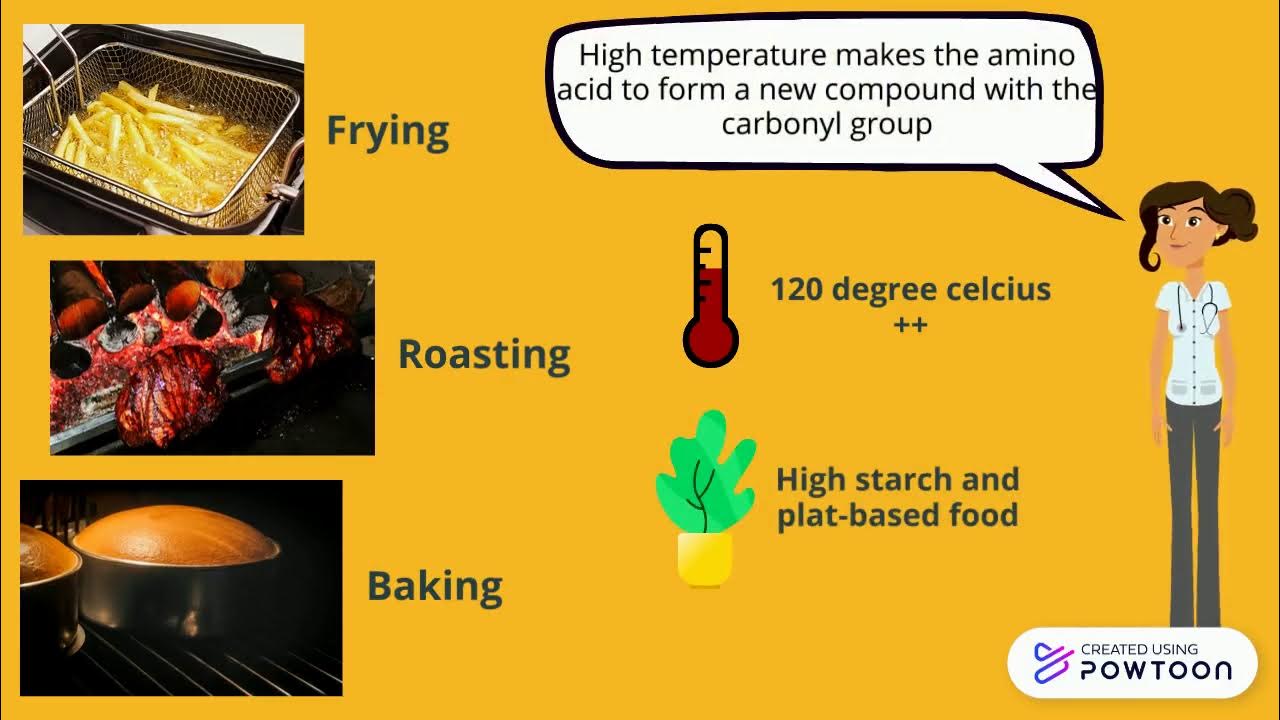What is Caramelization? | Knead to Know Basis | BAKERpedia
Summary
TLDRCaramelization is a non-enzymatic browning process where sugars are exposed to high temperatures, resulting in distinctive brown colors and flavors. This process involves complex reactions, starting with the decomposition of sugars like fructose and maltose, which then form volatile compounds and brown pigments. The rate of caramelization is influenced by factors like temperature, pH, and water activity. In baking, it’s crucial to control the process to avoid bitter flavors or overly dark colors. Ingredients like honey or high-fructose syrups speed up caramelization, enhancing flavor and texture in baked goods.
Takeaways
- 😀 Carmelization is a complex process that occurs when sugars are exposed to high temperatures, forming brown colors and distinct flavors in food.
- 😀 Unlike Maillard reactions, which require both sugars and free amino groups, caramelization only involves sugars as substrates.
- 😀 The process of caramelization can be influenced by factors like temperature, water activity, and pH.
- 😀 Caramelization involves a series of pyrolysis reactions where carbohydrates break down, leading to the formation of various molecules.
- 😀 Different sugars require different temperatures to caramelize, with fructose starting at 150°C and maltose at 180°C.
- 😀 Caramelization of sucrose can be divided into stages: decomposition, isomerization, and further fragmentation to form flavors and brown-colored compounds.
- 😀 The flavor compounds formed during caramelization include furan, maltol, ethyl acetate, and diacetyl, contributing to the characteristic caramel taste.
- 😀 Caramelization reactions should be controlled in baking to avoid excessive browning or bitterness in the final product.
- 😀 Baking products with honey or high fructose syrup will experience faster and more intense caramelization due to the presence of monosaccharides.
- 😀 The rate of caramelization varies with the sugar type, with fructose and glucose caramelizing the fastest, followed by lactose, maltose, sucrose, and isomalt.
Q & A
What is caramelization?
-Caramelization is a complex process where sugars undergo a series of reactions when exposed to high temperatures, forming brown colors and unique flavors. It is a non-enzymatic browning process that doesn't require amino groups like Maillard reactions.
What is the key difference between caramelization and Maillard reactions?
-While both are non-enzymatic browning processes, Maillard reactions require both sugars and free amino groups, whereas caramelization only involves sugars as substrates.
What factors influence the caramelization process?
-Caramelization is influenced by temperature, water activity, pH, and the type of sugar used. These factors determine the rate of caramelization and the types of compounds formed.
At what temperature does fructose begin to caramelize?
-Fructose begins to caramelize at around 150°C.
How does the caramelization process work on a chemical level?
-Caramelization begins with the decomposition of carbohydrates into monosaccharides like glucose and fructose. These sugars undergo further dehydration, fragmentation, and polymerization, eventually forming complex molecules and volatile flavor compounds.
What are some examples of volatile flavor compounds formed during caramelization?
-Some examples of volatile compounds produced during caramelization include furan, maltol, ethyl acetate, and diacetyl.
What are the stages involved in the caramelization of sucrose?
-The stages of sucrose caramelization include: 1) Thermal decomposition into glucose and fructose, 2) Isomerization of sugars, 3) Further fragmentation and polymerization to form volatile flavor compounds and brown-colored compounds.
What role does pH play in caramelization?
-pH significantly affects the rate of caramelization. It is slowest at pH 7 (neutral) and fastest at acidic pH levels.
Why do monosaccharides caramelize faster than disaccharides?
-Monosaccharides like fructose and glucose caramelize faster than disaccharides such as sucrose because they are simpler molecules that require less energy to break down and react.
How can caramelization be used in baking applications?
-In baking, caramelization can be used to create desirable flavors and colors in products like cakes, glazes, and toppings. It can also affect the texture and barrier properties of baked goods, and be used for decoration when hardened.
Outlines

This section is available to paid users only. Please upgrade to access this part.
Upgrade NowMindmap

This section is available to paid users only. Please upgrade to access this part.
Upgrade NowKeywords

This section is available to paid users only. Please upgrade to access this part.
Upgrade NowHighlights

This section is available to paid users only. Please upgrade to access this part.
Upgrade NowTranscripts

This section is available to paid users only. Please upgrade to access this part.
Upgrade Now5.0 / 5 (0 votes)





